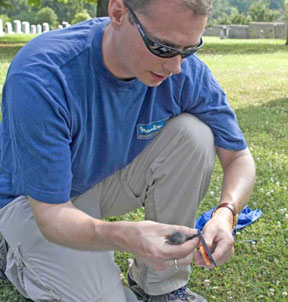Swaddle: Diverse bird population is good for human health

Researchers from the College of William and Mary have discovered thatwhat's good for an area's bird population also is good for peopleliving nearby—especially during an outbreak of West Nile virus, adisease which can be passed from wildlife to humans.
A study by biologist John Swaddle and an undergraduate student, StavrosCalos '08, found that areas which have a more diverse bird populationshow much lower incidences of West Nile virus infection in the humanpopulation. West Nile develops rapidly in bird populations, then can bepassed to humans or other animals through a vector mechanism, often amosquito.
The findings, published in the online peer-reviewed journal PLoS One,constitute the largest-scale application to date of the "dilutioneffect." Swaddle explained that the dilution effect is a patternwhereby increased biodiversity in wildlife results in lower risks ofhumans contracting "zoonoses," animal diseases which can infect humans.The dilution effect was first reported in Lyme disease, where ticksspread the disease from small mammals to humans. The Swaddle and Calosstudy is the first to demonstrate the dilution effect in a disease thathas bird hosts. Other zoonoses of concern, such as avian flu andbubonic plague, Swaddle said, may fit the dilution effect as well.
"Wedon't yet know the precise mechanism that drives this pattern, but it'slikely to be due to diverse areas having relatively few of the birdspecies that are particularly competent hosts and reservoirs for thevirus," Swaddle said.
Host competence, he explains, refers to a set of qualities that make aparticular species of bird best able to contract the disease and passit on through a vector. The highest levels of host competence are foundin crows, jays, thrushes and sparrows—the very birds that tend tothrive when avian biodiversity is reduced.
Swaddle pointed out some implications of his research. Very smallchanges in land management, he said, could attract more bird species,with the increase in biodiversity paying off in the form of lower humaninfection rates during outbreaks of West Nile or other zoonoses in thebird population.
Swaddle is an associate professor of biology and director of theenvironmental science and policy program at William and Mary. He beganthe work in conjunction with the interdisciplinary biomath program,which uses mathematical tools to explain biological phemonena. Hecompleted the work during the past year as a sabbatical fellow at theNational Center for Ecological Analysis and Synthesis in Santa Barbara,California.
"Biodiversity is giving us a public health service that people haverarely considered and the value of this service should be consideredwhen developing land and managing bird populations in the future,"Swaddle said.
The study is available at http://www.plosone.org/doi/pone.0002488.















